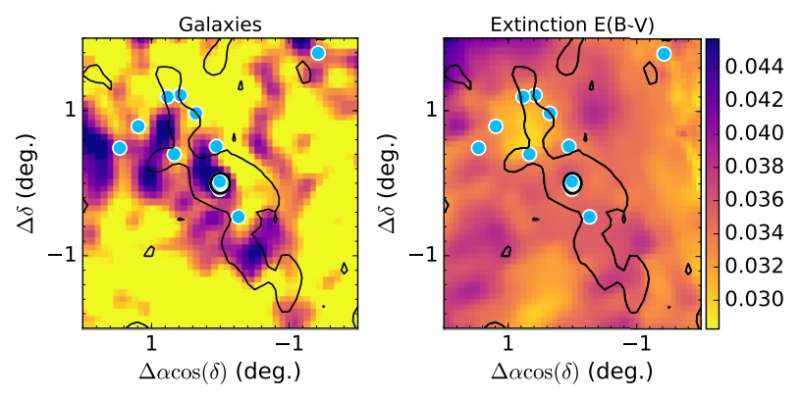Left: Number density of galaxies around the NGC 7492 globular cluster. Right: E(B − V ) extinction around the cluster. Credit: Navarrete et al., 2017.
(Phys.org)—Astronomers have found tidal tails around a distant globular cluster known as NGC 7492. The newly discovered features could provide important information about the nature of globular clusters. The findings were presented in a paper published May. 11 on the arXiv preprint repository.
Tidal tails are thin, elongated regions of stars and interstellar gas extending into space. They are formed as a result of gravitational interactions between galaxies and star clusters. Studying tidal tails offers clues on the tides experienced by the cluster and its internal dynamics. Such studies can also reveal essential information about the evolution of a cluster and could shed new light on the lumpiness of dark matter distribution in a galaxy.
To date, only a handful of clusters with tidal tails have been detected in the Milky Way galaxy. Seeking more examples of such clusters, a team of researchers led by Camila Navarrete of the Pontifical Catholic University of Chile searched for the presence of stellar tails around globular clusters located within the footprint of the Pan-STARRS1 (PS1) 3Pi survey. The survey offers multi-band, multi-epoch, precise photometry across much of the sky.
By analyzing the data provided by the first telescope of the Panoramic Survey Telescope and Rapid Response System (Pan-STARRS) program, located on Haleakala, Maui, Hawaii, the team found that a globular cluster, designated NGC 7492, has the features they were looking for. Located some 86,000 light years away from the Earth, NGC 7492 is a sparse outer-halo galactic globular cluster discovered by William Herschel in 1786. The presence of extra-tidal stellar material was suggested by previous studies and has been recently confirmed by Navarrete's team.
"We report the discovery of tidal tails around the galactic globular cluster NGC 7492, based on the Data Release 1 of the Pan-STARRS 1 survey," the astronomers wrote in the paper.
According to the study, NGC 7492 exhibits two tidal tails on either side of the cluster. These features extend in the north-south direction over approximately 3.5 degrees, which corresponds to about 4,900 light years in projected length. The authors noted that the newly detected structure resembles the characteristic "S-shaped" tidal feature found around other disrupting globular clusters, like Pal 5 and NGC 5466.
Pan-STARRS observations also revealed the positions of Blue Horizontal Branch (BHB) candidate stars in the cluster. The team found that despite their overall low number density, BHBs appear to follow NGC 7492's Northern tail, connecting its uppermost tip with the cluster itself. However, there is an observable lack of the BHB candidates on the other side of the cluster.
"This perhaps is not surprising, given the low number of BHB stars expected in a given stellar population. While the spatial distribution of the possible BHB candidates is suggestive, deeper wide imaging is required to confirm (and perhaps extend) the discovery presented here," the team concluded.
More information: The discovery of tidal tails around the globular cluster NGC 7492 with Pan-STARRS1, arXiv:1705.04324 [astro-ph.GA] arxiv.org/abs/1705.04324
Abstract
We report the discovery of tidal tails around the Galactic globular cluster NGC 7492, based on the Data Release 1 of the Pan-STARRS 1 survey. The tails were detected with a version of the matched filter technique applied to the (g−r,r) and (g−i,i) color-magnitude diagrams. Tidal tails emerging from the cluster extend at least ∼3.5 degrees in the North-East to South-East direction, equivalent to ∼1.5 kpc in projected length.
© 2017 Phys.org
























